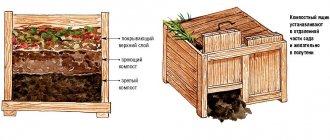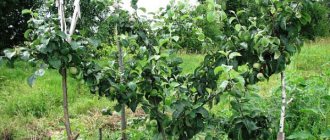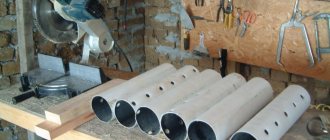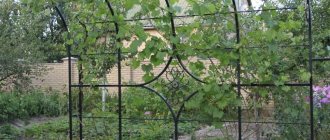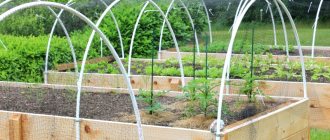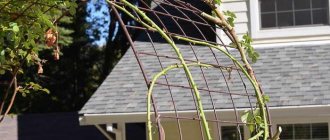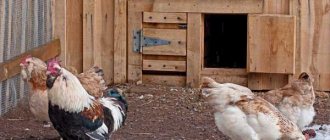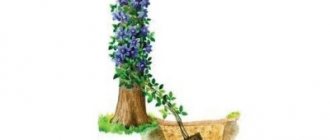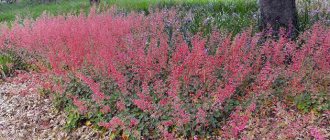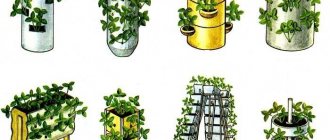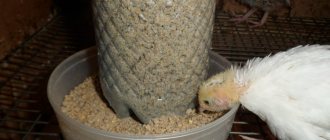What are the requirements for bush holders?
A lot depends on the size and shape of this simple element. The bush holder is part of the landscape design; it determines the appearance of the site.
The two-support sliding bush holder is convenient when installing on an already overgrown bush
There are a set of requirements for bush holders:
- Must have a normal margin of strength to cope with the loads from the bush, the branches of which can be covered with fruits;
Important! The product must withstand external influences, for example, gusts of wind, heavy rain.
- The design must be compatible with the plant on which it is installed. It should not interfere with the growth of branches, but it should not leave too much free space;
Bush holder on 4 supports
- The product must be practical. It is better to choose a dismountable one, which can be easily removed without damaging the plants, and returned to its place with the onset of the new season.
Advice! Why not leave the support for the winter? Why should it be in the open air, rust, absorb moisture and become ugly? In winter, the branches do not require support. They have neither foliage nor fruit.
- Safety. Neither the plants nor the people caring for them should be damaged by it;
- Materials should not emit toxic substances, polluting the environment or poisoning the plant.
Collapsible bush holder made of plastic pipes
If you choose a product according to all the above criteria, it will be convenient and durable. To save money, you can make it yourself. Homemade devices are often unaesthetic, but they are definitely reliable.
Fence made of slingshots and simple branches
A fence for currants made of slingshots and simple branches is one of the most budget-friendly structures. Rogatina can be made from unnecessary branches of a fruit tree on your site or found in the forest. If you don’t find a suitable material, you can make it yourself from boards.
DIY supports for currant bushes
The reverse end of the spear should be sharpened to make it easier to stick it into the ground. If the fence does not hold well in the ground, it can be secured with additional pegs. It is desirable that the branching angle of the spear be wide enough. Then the branch that will be attached from above will be able to fit tightly into its base.
Four spears are installed around the bush at the required height. Dry, strong branches are placed on top of the fork. Then they should be tied with rope or wire.
Additional Information. In the fall, such a support can be easily disassembled until the next season. In order for the product to be used for a long time, it must be dried and disinfected. The disadvantage of this fence is its low resistance to strong gusts of wind. Additional fixation of the slingshots with pegs is required.
Types of bush holders
Fences for bushes can be of different shapes and made of different materials, depending on the purpose and design.
Types of store products
Bush holders from manufacturers are usually made of metal or plastic. These products have the correct shape, but are not always of high quality. Here are the options you can buy:
| Type of bush holder, photo: | Description: |
Single post bush holder | The simplest product. It has a closed ring through which branches pass. This ring will prevent them from falling apart. It can be considered quite good if it is made of thick metal and the ring does not bend under pressure. The disadvantage is the instability of the structure if the bush begins to lean to one side. It is inconvenient to install on an already overgrown plant - you have to bend the edge of the ring and push the branches inside. |
Bush holder on two stands | The model is made in the form of a bracket that supports the plant on one side only. There are other options with closer racks. Their design is not much different from single-rack ones. Important! They are used mainly for decorative bushes, such as roses, and placed along paths. The products can be installed in pairs to support the bush on all sides. |
Three leg holder | This design has completely different indicators of stability and strength. It can hold heavy bushes without allowing them to sag in any direction. It may seem that a closed ring is difficult to install on a plant, but it is often made collapsible - the ring is divided into two parts, the legs are twisted. |
Four holder legs | Not much different from the previous one, since maximum stability is achieved with three points of support. The photo shows a plastic product with telescopic legs, which is convenient when adjusting the holder to the height of the bush. |
Bush holders are round and square in shape. The base is made in the form of a cone, cylinder, parallelepiped, glass or screw.
Two-tier cone-shaped bush holder
They can also be of different sizes. They are no more than 15 centimeters in height.
Strawberry bush holder - a detachable bracelet made of elastic plastic forms a support
Store-bought models of bush holders are made primarily from rods or hollow round pipes. This applies to both metal and plastic. Sometimes you can find products made from rectangular pipes or corners, but more often homemade options look like this.
Metal rods in a polymer shell are connected by plastic fittings
DIY bush holder made from scrap materials
Of course, the most popular models are made of steel and aluminum. The metal is strong and durable. Steel suffers from excess moisture. To avoid corrosion, it is painted with opaque paints.
However, metal is rarely chosen for self-production, considering that the process will require specialized tools. In fact, everything depends not on the material, but on the complexity of the design itself.
You can make two-post supports yourself by bending them from a single piece of reinforcement.
Bush holder made of solid rod
The second most popular material is wood. People use a variety of slats, bars, and boards, knocking together mostly rectangular structures from them.
Separately, it is worth noting products made from wooden rods - due to their flexibility, craftsmen make very beautiful, and most importantly, reliable bush holders. This is usually done to support roses, peonies, and climbing plants.
Homemade wooden structures are usually much simpler, but visually they can look no less attractive.
Simple bush holder
To make the simplest fence and at the same time attractive, you will need 3-4 sticks of the same length, which are dug around the bush in the form of the desired figure.
They are then connected with a taut rope. Additional dressings can be used to improve support for narrow bushes, as shown in the photo.
Bush holder made of sticks and rope
Metal and wood fencing
The racks are made of metal rods, bent at the top into special hooks, on which wooden slats are laid to create support. The design is designed in such a way that it is not even necessary to connect the parts to each other - they simply rest against each other.
Important! Such a bush holder can be disassembled with a wave of the hand, and can just as quickly be put back together.
Wooden and metal slats
Bush holder made of bars into slats
For such a design, you need 5 racks of the same height, which are connected at the top by jumpers made of slats. The parts are nailed together.
The design itself is reliable, but will very quickly lose its attractiveness if it is not treated with a protective compound, for example, soaked in oil or varnished.
Bush holder made of timber
Wooden box with trellises
The base is a wooden box decorated with carved strips and decorative overlays. The product can be used not only for support, but also as a large flowerpot. You can plant a decorative rose bush in it, which will immediately have strong support for rapid growth.
Base combined with trellises
Without additional tools, it is recommended to make bush holders yourself from wood.
PVC pipe fencing
Polypropylene or PVC pipes are an extremely versatile material, from which, using the principle of frame construction, you can build anything, including bush holders.
Bush holders made of PVC pipes
Important! The material has good elasticity, which will allow you to bend it even into a ring.
Raspberry support made of polypropylene pipes
A bush holder made of polypropylene pipes is assembled using self-tapping screws
Metal-plastic fencing
It is even better to use metal-plastic pipes as a material. They are much easier to bend, and at the same time they themselves hold their given shape.
To connect the parts you don’t need a soldering iron - just hammer a wooden chip inside. This, of course, can be done with the previous material, but the shape of the product will be incorrect.
The metal-plastic tube bends easily and has high strength
The disadvantage is that it is light and has a small margin of safety in terms of load without looping.
The main mistakes gardeners make when tying currants
People who make supports from scrap materials and tie currant bushes to them often make mistakes. The most common mistakes include:
- Use of low-quality materials. Sometimes people skimp on materials when building a support structure, which causes it to break down quickly.
- Choosing the wrong garters. Do not use natural fabrics that can damage the shoots.
- Pulling tied branches. Sometimes gardeners tie currant branches too tightly. This not only slows down its development, but also leads to drying out of the branch.
- One-time garter. Experts recommend regularly tying up currants as they grow.
How to make a bush holder for currants and other plants
There is nothing complicated in making a bush holder step by step.
Necessary tools:
- Screwdriver or screwdriver;
- Electric drill;
- Knife;
- Something for radius bending of pipes - for example, a can, a barrel, a disk from a car, or anything that you can pass material around. For metal, it is best to have a pipe bender. Bends at 90 degrees can be made using a vice;
- To weld PP pipes you need a special soldering iron and a pipe cutter for cutting;
- Tape measure and pencil.
There are other tools that will come in handy along the way depending on the material and design.
DIY metal bush holder for currants
The easiest option to manufacture is separate staples.
You only need two rods
Such brackets can be made from six reinforcement, any other metal rod, a thin profiled pipe of rectangular cross-section, or a metal-plastic pipe.
The first step is to cut a piece of metal to the required length. It is necessary to take into account the height of the legs and the length of the rounded part.
For powerful parts, for even bending around the circumference, you will need a special pipe bending machine, which is shown in the following photo.
Profile bending through a pipe bending machine
Thin fittings can be handled manually. To do this, you need to mark its center, grab it with your hands at the same distance from this point, and bend it through the same barrel, achieving the desired shape.
You can also bend the reinforcement using a regular hammer - the process is shown in the video clip attached to the article.
The legs are already bent at an angle of 90 degrees. To do this, they are clamped in a vice at the required points and bent with a hammer.
DIY bush holder made of plastic pipes
In addition to the pipes themselves, you will need several tees. In the photo below there are three legs to which tees are soldered.
The circle shape is not ideal
Soldering is performed with a special mounting soldering iron. The parts to be connected are preheated to the desired temperature, after which they are quickly inserted into each other and left to cool.
Soldering a polypropylene pipe with a fitting
Next, the legs are connected with three pieces of PP pipe of the same length. The last connection is the most difficult to make, since it will already loop the product.
Do it yourself
Currant bushes should be supported until the lower branches become woody and it will be difficult to lift them vertically without damaging the plant. Fences for supporting garden berry bushes can be purchased in specialized stores or made independently. Any gardener can quickly and inexpensively make supports and fences for currant bushes from scrap materials.
From the pegs
Wooden structures will cost the gardener the least, since any farm will have scraps of boards from which pegs and cross bars can be made. The length of the wooden pegs can be any, the main thing is that the above-ground part is at least 50 cm. In order for the structure to be reliable and withstand strong gusts of wind, it should be buried 25-30 cm into the soil. The pegs can form any geometric figure. It can be a triangle, rectangle or rhombus. After the support pegs are dug into the ground, their tops are connected by transverse bars. They are usually nailed down with nails or self-tapping screws. To prevent wooden elements from being exposed to moisture and rotting, they can be treated with a special varnish. This material will tell you about the features of growing Golden currants.
Experts recommend varnish that covers the bottoms of yachts. If there is no such varnish, then the pegs can be dipped in molten bitumen or coated with moisture-resistant enamel.
From the branches
It is very easy to make a fence from strong branches. To do this, take strong branches that have a bifurcation like a slingshot. Usually four spears are used, which are dug around the perimeter of the tree trunk circle. From above, the supports are closed into a square using even branches. The crossbars are fixed to the supports in any available way. Structures of this type are short-lived and, when planting currants in the fall, last only one season, but their low cost and ease of manufacture make it possible to assemble them many times using ordinary garden tools.
Metal fence
Metal construction is considered one of the most reliable and durable. To make it, you will need four pieces of pipe, which are dug in a square around the bush. To prevent moisture from getting inside the pipes, the holes are clogged with plugs. The side walls of the structure are constructed from any available materials.
If the farm has a welding machine, then fences for bushes can be welded from ordinary reinforcement. Having the appropriate skills, you can make a fence in the shape of a ring, rectangle, half-ring or other shape.
Made from PVC pipes
Using PVC pipes to make fencing supports is a very good option, although it will be more expensive than other types of supports. The design consists of two layers of polyvinyl chloride, between which there is an aluminum pipe. The outer plastic layer is not afraid of moisture, is not subject to rotting and destruction from temperature changes. For such pipes, various fittings are available for sale, which will be required for the manufacture of fencing. Angles, tees and plugs may be required. Pipes can be cut into pieces of the required length with a regular hacksaw. A properly manufactured pipe structure can be collapsible. Read about the features of growing onions by following this link.
Made of wood
Wooden fences can be made from any available material. For vertical posts, you can use trimmings of clapboard boards of the appropriate length. They dig in around the perimeter of the bush, forming a triangle or square. Cross members are cut from the same board, which are fixed to the supports by any means. They can be fastened with self-tapping screws or an aluminum corner can be used for fastening.
Wooden structural elements must be treated with anti-rotting agents, coated with durable varnish or painted.
Strawberry bush holder
Strawberry bush holders deserve special attention. They differ significantly from those discussed earlier, since their task is not only to support, but also to create a seat and hold the fruit above the ground.
Perimeter mesh prevents fruit from touching the ground
Usually they are made in the form of a round horizontal mesh, which is quite difficult to do at home, and it is inconvenient and expensive to supply each bush with such a support. Farmers involved in professional strawberry cultivation have taken a different route. He uses plastic sewer pipes as bush holders, from which many holes are drilled.
Strawberries growing in plastic pipes
Install them horizontally and vertically. Enriched soil mixture is poured inside, after which the plants are planted. The structure itself is raised to a height so that the strawberries do not touch the ground.
This design allows you to organize drip irrigation and get rid of weeds. The yields in such bush holders are very high.
Metal-plastic supports
Pipes made of metal-plastic are universal products that can easily be adapted for a supporting function. The main advantage of this material is that it is distinguished by the strength of metal products and resistance to moisture, which is achieved due to the outer polymer coating.
Note! Metal-plastic pipes can have different colors. If desired, you can purchase green parts that will blend in with the berry bushes. Let's consider the process of manufacturing a metal-plastic structure step by step
First of all, you will need to prepare all the necessary materials. For a standard support you need 4 segments 50 cm long and the same number of parts 70 cm each, as well as:
Let's consider the process of manufacturing a metal-plastic structure in stages. First of all, you will need to prepare all the necessary materials. For a standard support you need 4 segments 50 cm long and the same number of parts 70 cm each, as well as:
- screwdriver;
- self-tapping screws;
- rubber hose;
- wooden stakes;
- hammer.
It is worth saying that the wooden stakes should have such a diameter that it is possible to insert them into the lower part of the pipes. This will allow you to easily drive the metal-plastic parts into the ground. There are other ideas that can be used to connect pipes (for example, fiberglass reinforcement).
Metal-plastic supports
The joining of the pipes that will be used for the top piping is done using a rubber hose. Small jumpers are made from it. The diameter of this hose must be the same as that of the pipes. At the end, the finished ring is joined to the resistant ones. To do this, use a screwdriver and self-tapping screws. The resulting structure has good height and is quite stable.
Supports for berry plants perform a number of important functions, protecting the bushes from disease and death, as well as setting the direction of growth. Making supports for currants is not difficult - any gardener can make such frames with his own hands. When choosing a material, it is recommended to focus on its technical characteristics.
What recommendations can you give for installing supports for currants in the garden?
